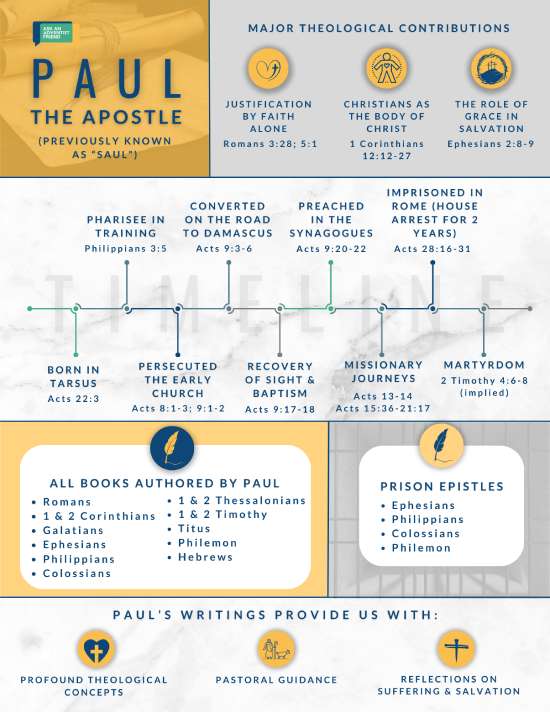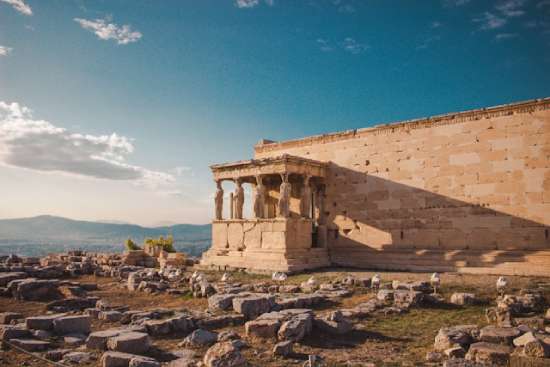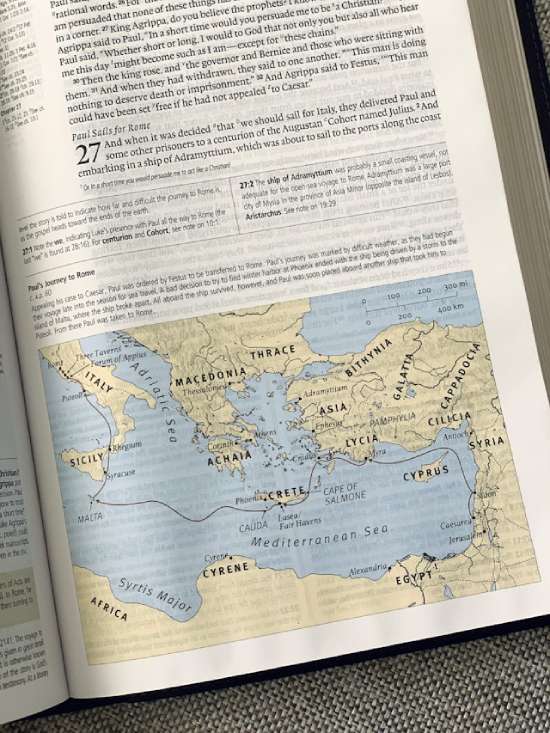 Christians today know the apostle Paul as a prominent figure in the early Christian church and a significant contributor to the New Testament.
Christians today know the apostle Paul as a prominent figure in the early Christian church and a significant contributor to the New Testament.
But before having this role, Paul’s life was headed in a much different direction. He was a Pharisee, or Jewish religious leader, who obsessed over following the law of Moses to the letter and was on a mission to persecute Christians.
That is, until he had a personal encounter with Jesus Christ.
Let’s find out how this transformation took place and what exciting, scary, and miraculous things made up the rest of the life of Paul. We’ll cover:
- Saul/Paul’s background
- How he became a follower of Jesus
- His involvement in the early Christian church
- His death
- His writings
- Major themes in his writings
- Lesson from his life
We’ll start with what the Bible says about Paul’s origins, education, and role before encountering Jesus. news of His sacrificial death and resurrection.
What was Paul’s background?

Photo by Arthur Yeti on Unsplash
According to Acts 22:3, Paul was a Jew who was born in Tarsus of Cilicia (modern-day Turkey). His birthplace gave him the privileges of a Roman citizen (Acts 22:25-29).
Because Tarsus was a town with a strong Greek influence, Paul likely had an understanding of the Greek religion and way of thinking—insight that would’ve proven beneficial to his ministry later on when he was seeking to reach out to Greeks.1
Though the Bible isn’t clear whether Paul learned a trade as a young man, we know that he made tents to support his ministry work (Acts 18:2-3). It’s possible he learned this skill when he was young.
Paul also went through rigorous training to become a Pharisee, a Jewish religious leader (Acts 23:6). In fact, he calls himself a “Hebrew of Hebrews,” perhaps because of his Jewish heritage and his education (Philippians 3:5). Scholars believe he studied first in Tarsus and later in Jerusalem to fulfill this role.2 At some point, he even trained under a well-known and influential Pharisee named Gamaliel (Acts 22:3; 26:4).3
So, from everything we can see in the Bible, Paul believed himself to be on the path to success in his religious pursuits. He was deeply convinced of his beliefs and willing to do anything to preserve them, even persecuting those who had chosen to become Christians.
The first time he’s mentioned in the Bible, Paul is present at the stoning of Stephen, one of the first Christian martyrs (Acts 8:1). Soon after, he “made havoc of the church, entering every house, and dragging off men and women, committing them to prison” (Acts 8:3, NKJV).
So how did this persecutor, who was “breathing threats and murder” against Jesus’ followers, suddenly become a follower himself (Acts 9:1, NKJV)?
We’ll find out soon. But first, a note about Paul’s names.
Paul’s names
Paul is also called Saul of Tarsus in the book of Acts. Since he’s referred to as Saul near the beginning of the book and then mainly as Paul later on, many have assumed that his name was changed to Paul when he became a Christian. However, the Bible doesn’t give us evidence for that.
Acts 13:9 makes it seem that Paul used both names even after choosing to follow Christ.
The Cambridge Companion to St. Paul confirms this idea by pointing out that Paul was a Latin name that he used when communicating with Graeco-Roman audiences.4 Saul, then, would’ve been his Hebrew name.
How did Paul become a follower of Jesus?
Paul was en route to Damascus to take Christians as prisoners when everything changed for him. A sudden, miraculous vision of Jesus put a halt to his mission to persecute Christians and led him to accept Jesus. The whole story is found in Acts 9, but we’ll look at some highlights here.
As Paul was on the way to Damascus, a bright light suddenly blinded him, causing him to fall to the ground.
The others around Paul saw him fall, but only he heard a voice speaking to him, “Saul, Saul, why are you persecuting Me?” (Acts 9:4, NKJV)
Paul responded, “Who are you, Lord?” (verse 5, NKJV)
“I am Jesus, whom you are persecuting. It is hard for you to kick against the goads” (verse 5, NKJV). Jesus then told Paul to go into Damascus, where he would receive instructions on what to do next.
When Paul opened his eyes after the vision, he couldn’t see anything, so his travel companions led him to Damascus. There, he spent three days in darkness, thinking about his life, situation, and the miraculous encounter he’d had with Jesus.
Meanwhile, through another vision, God instructed a Christian named Ananias to go to Paul and put his hands on him so that Paul would receive his sight again. Right afterward, Paul was baptized as a follower of Jesus.
In a matter of three days, he’d gone from a persecutor to a follower of Jesus.
And it wasn’t long before he was directing his zeal toward sharing his new faith. The Bible tells us that “immediately he preached the Christ in the synagogues, that He is the Son of God” (Acts 9:20, NKJV).
This was the start of his lifelong preaching and teaching ministry.
What was Paul’s involvement in the early Christian church?

Photo by Tim Wildsmith on Unsplash
Paul was deeply involved in the early Christian church. And though he wasn’t part of the original 12 disciples, he was connected with apostles like James and Peter. Next to them, he is probably one of the most well-known figures in the church at that time. He traveled throughout the Mediterranean region and Asia Minor, preaching the Gospel to Jews and non-Jews, starting churches, and encouraging the believers. His letters (epistles) to those churches form the bulk of the New Testament today.
But even though Paul began to preach about Jesus right away, he didn’t immediately win the trust of the church members and leaders (Acts 9:26).
After all, he had been their persecutor. They had every reason to be afraid of him!
Another church leader, Barnabas, played an important role in mentoring Paul and helping the church accept him (Acts 9:27). He would later join Paul’s first missionary journey into the Mediterranean region.
Though Paul shared the Gospel with everyone he came in contact with, he had a special calling from God to preach to the Gentiles, or non-Jews. We see this calling first in Acts 9:15 when God said:
“He [Paul] is a chosen vessel of Mine to bear My name before Gentiles, kings, and the children of Israel” (NKJV).
Paul himself spoke about this calling in one of his letters (Galatians 1:16; 2:6-9).
God led the way for Paul to embark on this mission when believers in Antioch, who were praying, became impressed that they needed to “lay hands” on Paul and Barnabas and send them out to do missionary work (Acts 13:1-3). Laying hands on them was a symbolic way of acknowledging their calling and praying for God’s blessing to guide them.
So Paul set off on his first missionary journey.
First missionary journey (Acts 13-14)
Paul’s first missionary journey took place from about AD 45 to 49. Barnabas and John Mark joined him, though John Mark later went home when overwhelmed by the hardships.
The places they visited included:
- Cyprus
- Perga
- Antioch in Pisidia
- Iconium
- Lystra
- Derbe
The main purpose of the trip was to preach about Jesus and establish Christian churches in these places.
Paul and Barnabas’s efforts went awry in Lystra, though, when the people of Lystra believed them to be gods and wanted to worship them and make animal sacrifices to them (Acts 14:8-18). Yet, no sooner had Paul stopped the crowds from doing this than they stoned him and left him nearly dead (Acts 14:19-20).
Despite the challenges, Paul and Barnabas persisted and at last returned to Jerusalem (the “headquarters” of the Christian church) around AD 50.
Second missionary journey (Acts 15:36-18:22)
After spending some time supporting the church in Jerusalem, Paul again prepared for another journey that would last from about AD 51 to 54.
This time, rather than Barnabas, Silas went with Paul.
As is often the case even when human beings work together, Paul and Barnabas disagreed on their plan of action. Barnabas wanted to take John Mark, who had deserted them on the last missionary journey, whereas Paul was unwilling for him to come (Acts 15:37-40). So he and Barnabas parted ways and continued to serve God separately.
Like the previous trip, Paul would visit new cities and share the Gospel there, but he also took the time to visit and encourage the churches he’d established during his previous trip.
He made it to:
- Derbe
- Lystra
- Phrygia and the region of Galatia
- Philippi
- Thessalonica
- Berea
- Athens
- Corinth
- Ephesus
A notable event during this journey was Paul and Silas’s imprisonment. While in Philippi, Paul healed a servant girl who was possessed by a demon that gave her the ability to tell fortunes (Acts 16:16-18). The master of the girl, angry that he’d lost his source of income, reported Paul and Silas to the authorities and had them arrested.
Despite the unideal outlook from prison, the two men chose to sing praise to God that night, resulting in God sending a powerful earthquake that freed them. Witnessing these miraculous events, the prison warden and his family learned about Jesus from Paul and Silas and received salvation.
Before returning to Israel, Paul and Silas stayed in Corinth for about a year and a half to teach there (Acts 18:11).
Third missionary journey (Acts 18:28-21:17)
Paul’s third missionary journey from about AD 54 to 58, involved visiting many of the places he’d been before, including:
- Derbe
- Lystra
- Iconium
- Antioch in Pisidia
- Phrygia
- Ephesus
- Philippi
- Thessalonica
- Berea
- Athens
- Corinth
- Troas
- Miletus
- Tyre
We don’t know who traveled with Paul this time, though it’s possible that Luke, the author of the Acts of the Apostles, did. The reason is Acts 20:13 mentions that “we”—the author of the book and others—joined Paul. Chapter 21 also contains many references to “we.”
On this journey, Paul spent two years in Ephesus, teaching at the school of Tyrannus (Acts 19:9-10). His time there came to an abrupt end, though, when a silversmith Demetrius stirred up a riot because the converts to Christianity were taking away his business as an idol maker (Acts 19:21-20:2).
The dangers were not over, unfortunately. As Paul was returning to Jerusalem, he stopped in Caesarea, where some Christians warned him that he would be imprisoned if he returned to Jerusalem (Acts 21:10-12). But Paul responded:
“I am ready not only to be imprisoned but even to die in Jerusalem for the name of the Lord Jesus” (Acts 21:13, ESV).
And arrest, indeed, awaited him.
Arrest and imprisonment

Photo by Ehsan Habashi on Unsplash
When Paul returned to Jerusalem, Jews who disliked him stirred up a mob against him in the temple, resulting in his arrest and eventual trial by Roman authorities (Acts 21-23). He used his Roman citizenship to appeal to Caesar and eventually ended up in Rome as a prisoner (Acts 25:10-12).
He remained on house arrest there for two years (Acts 28:30).
Additional travel
The book of Acts, which records many of Paul’s journeys, ends with his imprisonment in Rome, so we don’t know for sure what happened afterward.
It’s possible that Paul was again released from prison and able to travel since some of his epistles (letters)—which were thought to have been written during or after this imprisonment—hint at his intentions to visit additional places like:
- Spain (Romans 15:24-25)
- Judea or Jerusalem (Hebrews 13:23)
Some of these later epistles of Paul also speak about travels to:
- Crete (Titus 1:5)
- Nicopolis (Titus 3:12)
- Ephesus (1 Timothy 1:3; 3:14-15)
- Troas (2 Timothy 4:13)
- Miletus (2 Timothy 4:20)
How did Paul die?
Though Scripture isn’t clear on how or when Paul died, 2 Timothy 4:6-8 implies that he was imprisoned again and awaiting death:
“For I am already being poured out as a drink offering, and the time of my departure has come. I have fought the good fight, I have finished the race, I have kept the faith. Henceforth there is laid up for me the crown of righteousness, which the Lord, the righteous judge, will award to me on that day, and not only to me but also to all who loved his appearing” (ESV).
Tradition suggests that Paul died by beheading at the hands of the Roman emperor Nero:
“The New Testament nowhere mentions his death, but reliable traditions depict him as a martyr in Rome, beheaded during the persecution of Nero in the mid-60s CE.”5
But regardless of exactly when or how Paul died, God used his life to accomplish extraordinary things. He left an unmatched legacy—not only of starting and nurturing many early Christian church communities, but also of rich theological writings and counsel for generations to come. We’ll look at those next.
What parts of the Bible did Paul write?

Photo by Kelly Sikkema on Unsplash
Paul wrote 14 of the 27 books of the New Testament:
- Romans
- 1 and 2 Corinthians
- Galatians
- Ephesians
- Philippians
- Colossians
- 1 and 2 Thessalonians 1 and 2 Timothy
- Titus
- Philemon
- Hebrews
The majority of these books are “epistles,” long letters with counsel and guidance for the churches Paul helped start. Church members would read these letters out loud to their congregations, as Paul intended.
Scholars point out that “literary epistles were common in the Roman world. … Though Paul followed the style of the day, in some ways his letters are not literary works. He was essentially a speaker, and his letters contain what he would have said had he been physically present.”6
Thus, when we read these epistles today, it’s almost like listening to one side of a telephone conversation. From the whole of the epistle, we have to try to understand what might have been happening on the other end that Paul was addressing.7
One epistle of Paul’s that is unique from the rest is the book of Hebrews.
Rather than being an epistle, the author of this book calls it an “exhortation” (Hebrews 13:22)—what we might consider a sermon.8
Many scholars have questioned whether Hebrews was actually written by Paul due to its unique style and difference in theological emphasis. However, the Christian church of the first few centuries didn’t seem to question its authorship and accepted it quite early into the Canon of the Bible.9
As early as AD 96, a work of Christian literature called First Clement, or First Letter of Clement, mentions Hebrews together with other writings by Paul.10
Evidence within the text of Hebrews also tells us Paul probably wrote it. For example, Hebrews 13:20-25, the close of the book, has many similarities to the way Paul ends some of his other epistles, like Romans, 2 Corinthians, Philippians, or 1 Thessalonians.11 Hebrews also refers to Timothy, someone who worked very closely with Paul (Hebrews 13:23).
So, now that we have a general idea of the Bible books Paul wrote, let’s find out more about their content.
What are major themes in Paul’s letters?
If we could sum up Paul’s emphasis throughout his writings in one word, it would be the Gospel. From Paul’s transformative experience on the Damascus road onward, his focus was what Jesus Christ did for humanity—His life, death, and resurrection—and how that impacts our lives.
He sums it up in Romans 1:16-17:
“I am not ashamed of the gospel, for it is the power of God for salvation to everyone who believes, to the Jew first and also to the Greek. For in it the righteousness of God is revealed from faith to faith” (ESV).
The power of the Gospel is the overarching theme that shapes everything else in the Pauline epistles:
The Cross
The Cross was not a religious concept back in Paul’s day—it was a torture device. A God who would die on a Cross wasn’t a popular or appealing idea then. And yet, Paul wrote,
“We preach Christ crucified, to the Jews a stumbling block and to the Greeks foolishness, but to those who are called, both Jews and Greeks, Christ the power of God and the wisdom of God” (1 Corinthians 1:23-24, ESV).
The Cross revealed a God who was willing to humble Himself in self-sacrifice to save His people (Philippians 2:5-8). Paul showed how Christians can enter into that crucifixion by allowing their sinful natures to be crucified with Christ (Galatians 2:20). By faith, we accept Jesus’ death and allow Him to help us die to our selfishness and sin.
Jesus’ resurrection
Jesus’ death showed humanity how far He’s willing to go to save us. But it was His resurrection that made His sacrifice for humanity complete. Paul highlights this in 1 Corinthians 15, a well-known passage about the resurrection. He points out how “Christ died for our sins in accordance with the Scriptures, that He was buried, that He was raised on the third day in accordance with the Scriptures” (1 Corinthians 15:3-4, ESV).
He goes on to say that “if Christ has not been raised, then our preaching is in vain and your faith is in vain” (verse 14, ESV).
Because Jesus rose from the dead, He’s able to save us from the power of sin and make it possible for His followers to be resurrected at His Second Coming (1 Thessalonians 1:9-10; 1 Corinthians 15:52).
Salvation and righteousness by faith

Photo by Greg Rosenke on Unsplash
Many of Paul’s epistles focus on how we receive salvation and God’s goodness by faith rather than by our own efforts of obedience. The book of Romans especially highlights this idea.
During Paul’s time, a major issue in the early Christian church was false teachings that were being spread by Judaizers. These were Jewish Christians who believed that Christians needed to keep the Jewish laws from the Old Testament, such as the practice of circumcision, in order to be saved. For this reason, he especially emphasized salvation by faith.
This theme comes up in many places:
- Galatians 3 speaks out against believing salvation can come through the ceremonial law
- Ephesians 2:11-13 shows how Jesus did away with the ceremonial law
- Philippians 3:1-9 says that the works of the law don’t give us any merit
- Ephesians 2:8-9 emphasizes salvation through grace by faith
- Hebrews 11 traces believers all through Old Testament history who received salvation from God by faith
Jesus’ ministry in the heavenly sanctuary
As a high-ranking Jew, Paul understood the intricacies of the Israelite sanctuary, or temple, on earth and recognized that it reflected Jesus’ sacrifice and ministry in the heavenly sanctuary. Much of the book of Hebrews, then, is about how Jesus’ ministry in heaven is superior to the earthly one.
Hebrews 8:1-2 sums it up:
“Now the point in what we are saying is this: we have such a high priest, one who is seated at the right hand of the throne of the Majesty in heaven, a minister in the holy places, in the true tent that the Lord set up, not man” (ESV).
Counsels to the church
As we pointed out earlier, Paul’s epistles were messages to the churches, specifically counsel for how the new churches were to operate. They provided guidance and encouragement, as well as cautions and warnings, for both church members and leaders.
The epistle of 1 Timothy, for example, has counsel to Timothy, a young leader in the church, on appointing overseers and deacons in the church and dealing with false teachers.
Similarly, 1 Corinthians deals with many specific issues in the church and talks about how the church is like a body with different parts that function in unity with one another (12:12-27).
Warnings against false teachings
Considering the spiritual war between good and evil that is taking place in our world, it’s not surprising that Paul often had to deal with false teachings. We see evidence of this in what he wrote to the Galatian Christians:
“I marvel that you are turning away so soon from Him who called you in the grace of Christ, to a different gospel” (Galatians 1:6, ESV).
One of the main errors he encountered was the teaching that Christians could earn salvation through the keeping of Jewish ceremonial laws.
Paul also warned that false teachings would continue to be an issue down to the time before Jesus’ coming (2 Timothy 4:3-4), and to help us discern between truth and error, we should pray for the guidance of the Holy Spirit (Ephesians 6:18).
Though these false teachings may look a little bit different now than back then, the principles in His writings are still applicable and helpful to us today.
The last days
Jesus’ life, death, resurrection, and heavenly ministry make it possible for Him to someday return and take us to be with Him. This is why Paul spoke about His return throughout His epistles, encouraging believers to be ready for that time and not be caught unprepared (1 Thessalonians 4-5).
First Thessalonians 4:16-17 is an especially well-known passage where Paul talks about how Jesus will return in a glorious procession with all the angels and the sound of a trumpet—something everyone on earth will see. At that time, the dead in Christ will rise to be with Him.
But Paul also wrote about some of the signs and events that would happen before that time. He explains the corruption that will take place in the last days (2 Timothy 3:1-5) and how people will turn away from God because of the “man of sin” who will attempt to put himself in the place of Jesus (2 Thessalonians 2).
Yet, the focus of these warnings is not to scare anyone but to prepare us. Ultimately, Paul’s writings point us to Jesus’ coming as our “blessed hope” (Titus 2:13, NKJV).
What lessons can we learn from Paul’s life?

Photo by Suzanne D. Williams on Unsplash
Paul’s life offers hope for the Christian journey, reminding us of God’s ability to transform a life and use it for incredible good. Paul was a human, just like us, with plans and goals that were taking him away from God’s purpose, and yet God was able to redirect his path and use him to lead many people to Jesus.
So, what are some lessons we can learn from this incredible change in his life, and his ministry afterward?
God’s ability to transform our lives
Paul was on a trajectory as a Jewish religious leader, convinced that he was doing the right thing and following God while persecuting Christians. To him, Jesus was the enemy.
And yet, God saw Paul’s heart and knew that he had a willingness. He reached out to Paul in a way that got His attention.
The rest of what the Bible says shows us the 180° transformation in Paul’s life. It encourages us that God can do the same today—no matter how far someone seems to have gone away from Him. He can work in hearts to draw them to Himself, no matter how hardened they may be toward Him.
What seems humanly impossible is possible with God.
Redirection of skills and abilities
Something we notice about Paul is that his personality, skills, and talents didn’t change when He became a Christian. Instead, God took those and directed them toward spreading the Gospel.
Paul’s zeal for the law became zeal for Christ.
Paul’s determination to persecute Christians became a determination to spread the Gospel of Christ as far as possible throughout the then-known world.
God used his oratory skills, his ability to reason, and his knowledge of Greek religion and culture to reach out to those around him in the best way possible.
For example, while visiting Athens, Paul saw an altar to the unknown god that the Greeks had erected. Using this altar to connect with the people, he directed them to the God they didn’t know about—the Creator and God of the Scriptures (Acts 17:22-30).
Similarly, when we are born again as followers of Jesus, He takes our talents and skills and uses them for His glory. We don’t lose our individuality or what makes us unique; rather, we direct those qualities into serving God and others.
Reliance on Christ’s power
While Paul allowed God to use his natural abilities, he recognized the importance of not letting those abilities get in the way of relying on Christ’s power. Paul was convinced that nothing else could make His work effective:
“For I determined not to know anything among you except Jesus Christ and Him crucified. … And my speech and my preaching were not with persuasive words of human wisdom, but in demonstration of the Spirit and of power, that your faith should not be in the wisdom of men but in the power of God” (1 Corinthians 2:2-5, NKJV).
Human frailty
Though Paul was used by God in a powerful way, he was still human and struggled just like we do.
One instance of this is when Barnabas, Paul’s fellow missionary, felt that he and Paul should give John Mark a second chance after he abandoned them during their first missionary journey. But Paul disagreed and refused to do so (Acts 15:37-40). As a result, he chose to no longer work with Barnabas in ministry.
We also see Paul’s human weakness when he struggled with what he calls a “thorn in the flesh” (2 Corinthians 12:7-9). Though we don’t know exactly what his “thorn in the flesh” was, scholars believe it may have been a physical condition with his eyes.12 Regardless, Paul struggled with this condition and begged God to take it from him. He was human and didn’t want to face the struggle.
And yet, he ultimately chose to accept it as something that would teach him to depend more fully on Christ (verse 9).
These experiences show us that even as we follow God, we’ll struggle. We’ll still run up against conflict with others or have to deal with trials. Through it all, God is teaching us and helping us to become more like Him.
Perseverance
It was Paul’s love for Christ that drove him to press on despite difficulty. He preached the Gospel, even when facing all kinds of hardships and persecution. Notice his words in 2 Corinthians 11:25-28:
“Five times I received at the hands of the Jews the forty lashes less one. Three times I was beaten with rods. Once I was stoned. Three times I was shipwrecked; a night and a day I was adrift at sea; on frequent journeys, in danger from rivers, danger from robbers, danger from my own people, danger from Gentiles, danger in the city, danger in the wilderness, danger at sea, danger from false brothers; in toil and hardship, through many a sleepless night, in hunger and thirst, often without food, in cold and exposure. And, apart from other things, there is the daily pressure on me of my anxiety for all the churches” (ESV).
His work was far from easy, and he had plenty of reasons for discouragement.
And yet, he didn’t allow any of these challenges to stop him from preaching the Gospel, establishing churches, and continuing to support new believers. His life is an example for us of what it means to persevere.
Driven by passion for the Gospel
Paul’s life underwent a complete transformation—from Pharisee and persecutor to a fully devoted follower of Jesus. From that point onward, he threw all his energies into preaching the Gospel, establishing churches, and teaching new believers. And it was his counsel to these churches that form much of the New Testament today.
Above all, the one theme we see all throughout Paul’s life is a love for Christ—the one who turned his life around—and a passion for preaching the good news of His sacrificial death and resurrection.
Related Articles
- Coogan, Michael, Oxford Companion to the Bible, p. 577. [↵]
- Ibid., p. 576. [↵]
- Nichol, F. D., ed., Seventh-day Adventist Bible Commentary, vol. 5, p. 184-185. [↵]
- Dunn, James D. G., ed., The Cambridge Companion to St Paul (Cambridge University Press, 2003), p. 21. [↵]
- Oxford Companion to the Bible, p. 576. [↵]
- Ibid. [↵]
- Ibid. [↵]
- Cortez, Felix, “On the Authorship of Hebrews: The Case for Paul,” Ministry, September 2022. [↵]
- Swindoll, Chuck, “Hebrews,” Insight for Living Ministries. [↵]
- Cortez, “On the Authorship of Hebrews: The Case for Paul.” [↵]
- Compare with Romans 15:33; 16:20; 2 Corinthians 13:11; Philippians 4:9; and 1 Thessalonians 5:23. [↵]
- Nichol, Seventh-day Adventist Bible Commentary, comments on 2 Corinthians 12:7. [↵]
More Answers
Getting to Know Mark—Gospel Writer and Follower of Jesus
Mark (whose full name was John Mark) had a lot of roles in the New Testament: he was an early follower of Jesus Christ, he traveled the Mediterranean as a Christian missionary, and he wrote a book of the Bible.
Understanding Luke: The Beloved Physician, Historian, and Evangelist
Who was Luke in the Bible? What was he known for and what contributions did he make for the early church? Find out here.
All About the Disciple, Simon the Zealot
“Simon the Zealot” was one of the 12 disciples chosen by Jesus Christ. But despite this important role, the New Testament doesn’t provide specific details about his life, family, job, etc.
Judas Iscariot, the Most Infamous Disciple of Jesus
Judas Iscariot is best known for betraying Jesus with 30 pieces of silver. This page looks more closely at who he was and what led him to do so.
Who Is Thaddeus, the Disciple?
Thaddeus (or Thaddaeus) is one of the more unique and obscure figures among Jesus Christ’s disciples in the New Testament. Though we know little about him from the Bible or tradition, we do know that he went by a few names, specifically Thaddeus, Lebbaeus, and Judas of James.
Matthew—From Tax Collector to Jesus’ Disciple
In the first book of the New Testament, we find the Gospel story from the perspective of Matthew. He was a Jewish tax collector from Capernaum in the first century AD, and he was likely despised by fellow Jews for choosing that profession.
Who Was Jesus’ Disciple Named James, Son of Alphaeus?
Two of Jesus’ 12 disciples were named James. While more is known about James the son of Zebedee and brother of John, let’s see what there is to know about the other James, known as James the son of Alphaeus—also sometimes referred to as “James the Lesser.”
What the Bible Tells Us About Thomas the Apostle of Jesus
You might know him as “Doubting Thomas” because he refused to believe in Jesus Christ’s resurrection without first seeing Jesus.
All About the Disciple James, Son of Zebedee
James the son of Zebedee was a fisherman who became Jesus’ disciple. Discover how his decision to follow Jesus shaped his life and the beginnings of the early Church.
Who was the Apostle John?
What does the Bible say about the apostle John? What is he known for today? Learn more about John’s life, ministry, and legacy here.
All About Bartholomew, a Disciple of Jesus
Even before Bartholomew met Jesus, he was eagerly awaiting the arrival of the Messiah. Discover how he came to follow Jesus and what his discipleship means for us today.
What Do We Know About Andrew the Disciple?
Andrew was Jesus Christ’s first disciple (John 1:37-40) and the first to recognize Him as the Messiah.
Simon Peter: Fisherman to Disciple to Apostle
Simon Peter was a simple fisherman who became one of the most well-known disciples of Jesus Christ. He is perhaps best known for being part of Jesus’ inner circle of three disciples, walking on water, and proclaiming Jesus as the Son of God.
Who Was Philip the Disciple In the Bible?
Philip was one of the 12 disciples called by Jesus Christ during His earthly ministry. He was originally from the city of Bethsaida and to this day is often known as the “practical disciple.”
King David: How Was He a Man After God’s Own Heart?
War, bloodshed, murder, adultery—all of these crimes overshadowed the life of a biblical Old Testament man named David. Yet he was called a man after God’s own heart, not to mention one of Israel’s greatest heroes and kings.
The Story of Moses in the Bible: What His Life Teaches Us
A baby on death row, an outcast prince, a humble shepherd, and an unlikely deliverer. All these titles describe the individual that led Israel out of slavery in Egypt to the borders of the Promised Land.
The 42 Kings (and 1 Queen) of Israel and Judah in the Bible
Conspiracies, royal scandals, dictatorships—history is full of them. And Bible history is no different when we stop to look at the kings of ancient Israel in the Old Testament.
Who Were the Israelites in the Bible?
The Israelites in the Bible, also known as the children of Israel or ancient Israel, were a nation God called to represent Him to the world. As recorded in the book of Exodus, He delivered them from slavery in Egypt under Moses’s leadership and brought them to the Promised Land of Canaan (located in a similar area to present-day Israel).
What We Can Learn from the Life of Joshua
Joshua was an iconic leader in the Old Testament of the Bible. As a successor to Moses, he was both a humble servant of God and a strong warrior. God called Him to lead the nation of Israel to take possession of Canaan, the Promised Land—a task he took on with faith and courage.
Why is Abraham Important in the Bible?
God communicated directly with Abraham and made a covenant with him that would provide land, protection, and fruitfulness for his descendants. And he indeed became the father of many nations, making him a foundational figure in three monotheistic world religions: Judaism, Islam, and Christianity (Genesis 17:5, 19-20; Genesis 25:1-6, 12-18).
Who Were the Judges of Israel in the Old Testament?
Times of crisis call for men and women of action. The Israelites, newly settled in the Promised Land, found themselves in those times. As enemy nations attacked and oppressed the tribes, they cried out to God for help. He, in turn, sent them men and women of action—known as judges.
Life Lessons from Joseph in the Bible
Joseph is one of the more well-known people from the Bible’s Old Testament. He showed remarkable strength, faith, and patience—even while facing great difficulty and injustice. All because he let God lead.
Didn’t find your answer? Ask us!
We understand your concern of having questions but not knowing who to ask—we’ve felt it ourselves. When you’re ready to learn more about Adventists, send us a question! We know a thing or two about Adventists.



























